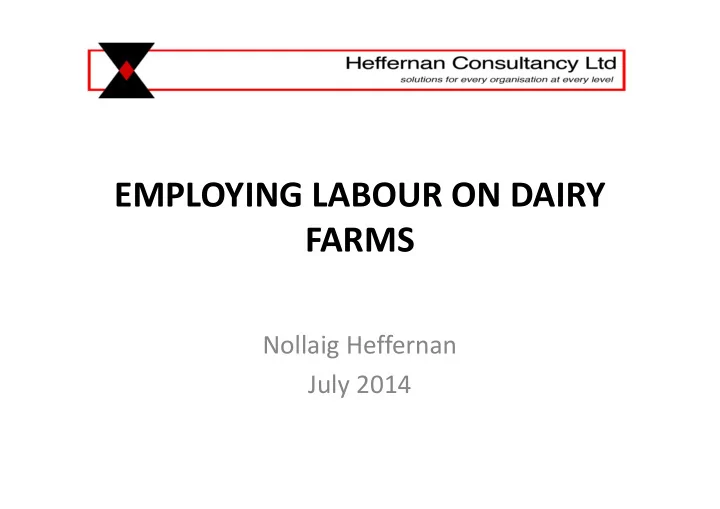

EMPLOYING LABOUR ON DAIRY FARMS Nollaig Heffernan July 2014
CHANGE MANAGEMENT: BUSINESS OR PERSONAL? Driven by Implemented Economics by People (Business) (Personal)
Notes (Teagasc) • Human resource skills are skills that can be learned. • Expansion is change. – First and foremost it needs to be decided if this is the right thing for YOUR farm, not just because the farmer down the road is doing it. It’s critical – Any change you take on should have a financial benefit and personal- will have an impact on you and the people around you
SWOT ANALYSIS STRENGTHS WEAKNESSES maintain remedy INTERNAL build or exit leverage OPPORTUNITIES THREATS EXTERNAL prioritise counter optimise
Notes (Teagasc) • SWOT analysis useful tool when analysing business – Strengths • Cow herd? • Facilities? – Opportunities • Potential to expand? • Good work force available? – Threats • Contingency planning • What happens if the milk price drops? • Limiting factor – Weakness • Having a weakness means there’s an opportunity to improve
ALIGNING DEVELOPMENT WITH STRATEGIC DIRECTION What is needed to What am I\are we trying to achieve that? (Top accomplish? down) Current knowledge, COMPETENCY Gap skills and capabilities REQUIREMENTS Analysis Human Resource What do staff have Development Plan to offer? (Bottom up) (Adapted: Thompson & Mabey 1994)
Notes (Teagasc) • Gap analysis slide – Helps to have a business mission statement (can be very difficult to pinpoint) – Gap – countering threats of swot analysis • Where are we now, where do we want to be? • What’s the gap in your system now that’s going to prevent you from being as good as you can be? – Be aware you may be the biggest block in moving forward. Self awareness…look at your own skills gap and looking to improve those
THE BEST PERSON FOR THE JOB… • Job Description – What the job entails Do you actually know what you do? • Job Specification – What is required to do the job
Notes (Teagasc) • Best person for the job – Being able to articulate what you want in SPECIFIC • Avoid generalized statements like ‘hard worker’ there are different interpretations to that. Are you working hard or are you working efficiently? – Potentially going from ‘this is my absolute ideal employee’ and breaking it down to what can you tolerate – Be able to articulate what it is you do (specifically step by step) • Creating clarity (through Standard operating procedures (SOPs)) removes fear and anxiety and stress (an unhappy employee) • Lack of job clarity is one of the biggest sources of job dissatisfaction
CREATING COMMITMENT (Situational Leadership Theory - Hersey & Blanchard, 1969) 1. FOLLOWER: 2. FOLLOWER: High Commitment (positive attitude) Low Commitment (negative attitude) Low Competence (low ability) Low Competence (low ability) Disillusioned Enthusiastic Learner Beginner Leader Response: Leader Response: TELLING/DIRECTING SELLING/COACHING 4. FOLLOWER: 3. FOLLOWER: High Commitment (positive attitude) Low Commitment (still quite negative) High Competence (great ability) High Competence (good ability) Capable but High Achiever Cautious Performer Leader Response: Leader Response: DELEGATING PARTICIPATING/SUPPORTING
Notes (Teagasc) Creating commitment • – Responding appropriately to employees 1. Highly motivated, new employee, doesn’t really know what doing 2. As going along in job, not positive you like what you’re doing (negative attitude), doubts start to settle in, might still not be very competent. Manager needs to facilitate more and respond to emotional output of that individual 3. Still cautious but know the business. Manager can incorporate employee asking their opinions (letting them take ownership), getting them involved 4. Delegating is the point when you can leave the farm and know that everything is running fine without you and you can take a holiday with ease of mind Any employee can be on any one of those quadrants at any one time • Have to respond to the individual in regards to where they are in that time for that • task. Just because they know how to milk doesn’t mean they’re competent with machinery Important to do self-reflection. When you think you have an incompetent • employee, think about how you failed to prepare them!
TASK PRIORITISATION HIGH IMPORTANCE Communication tool URGENT NOT URGENT IMPORTANT IMPORTANT HIGH URGENCY LOW URGENCY URGENT NOT URGENT NOT IMPORTANT NOT IMPORTANT LOW IMPORTANCE
Notes (Teagasc) • Task prioritisation – The ultimate in leadership is to become obsolete – Idea behind quadrants is everything done should be in relation to moving towards ‘not urgent, important’ • Those are your goals of what you’re working to in your lifestyle or business • ‘I want to expand to x# cows and x# acres by this age’ or ‘I want to be able to retire by 55’ – True delegation and succession planning is asking someone to do something above their workload in order to move up.
THANK YOU!
Recommend
More recommend